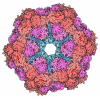[English] 日本語
 Yorodumi
Yorodumi- PDB-7n00: Anaplastic lymphoma kinase (ALK) extracellular fragment of ligand... -
+ Open data
Open data
- Basic information
Basic information
| Entry | Database: PDB / ID: 7n00 | |||||||||||||||||||||||||||||||||||||||||||||||||||||||||||||||||||||||||||||||||||||||||||||||||||||||||||||||||||||
|---|---|---|---|---|---|---|---|---|---|---|---|---|---|---|---|---|---|---|---|---|---|---|---|---|---|---|---|---|---|---|---|---|---|---|---|---|---|---|---|---|---|---|---|---|---|---|---|---|---|---|---|---|---|---|---|---|---|---|---|---|---|---|---|---|---|---|---|---|---|---|---|---|---|---|---|---|---|---|---|---|---|---|---|---|---|---|---|---|---|---|---|---|---|---|---|---|---|---|---|---|---|---|---|---|---|---|---|---|---|---|---|---|---|---|---|---|---|---|
| Title | Anaplastic lymphoma kinase (ALK) extracellular fragment of ligand binding region 648-1025 in complex with AUG-alpha | |||||||||||||||||||||||||||||||||||||||||||||||||||||||||||||||||||||||||||||||||||||||||||||||||||||||||||||||||||||
 Components Components |
| |||||||||||||||||||||||||||||||||||||||||||||||||||||||||||||||||||||||||||||||||||||||||||||||||||||||||||||||||||||
 Keywords Keywords | TRANSFERASE / Anaplastic lymphoma kinase / Receptor tyrosine kinases / RTK / FAM150 / DE NOVO PROTEIN | |||||||||||||||||||||||||||||||||||||||||||||||||||||||||||||||||||||||||||||||||||||||||||||||||||||||||||||||||||||
| Function / homology |  Function and homology information Function and homology informationpositive regulation of ERK5 cascade / ASP-3026-resistant ALK mutants / NVP-TAE684-resistant ALK mutants / alectinib-resistant ALK mutants / brigatinib-resistant ALK mutants / ceritinib-resistant ALK mutants / crizotinib-resistant ALK mutants / lorlatinib-resistant ALK mutants / MDK and PTN in ALK signaling / receptor signaling protein tyrosine kinase activator activity ...positive regulation of ERK5 cascade / ASP-3026-resistant ALK mutants / NVP-TAE684-resistant ALK mutants / alectinib-resistant ALK mutants / brigatinib-resistant ALK mutants / ceritinib-resistant ALK mutants / crizotinib-resistant ALK mutants / lorlatinib-resistant ALK mutants / MDK and PTN in ALK signaling / receptor signaling protein tyrosine kinase activator activity / regulation of dopamine receptor signaling pathway / response to environmental enrichment / transmembrane receptor protein tyrosine kinase activator activity / ALK mutants bind TKIs / swimming behavior / phosphorylation / Signaling by LTK / positive regulation of dendrite development / regulation of neuron differentiation / peptidyl-tyrosine autophosphorylation / Signaling by ALK / response to stress / adult behavior / neuron development / negative regulation of lipid catabolic process / energy homeostasis / transmembrane receptor protein tyrosine kinase activity / cell surface receptor protein tyrosine kinase signaling pathway / cytokine activity / hippocampus development / positive regulation of NF-kappaB transcription factor activity / positive regulation of neuron projection development / receptor protein-tyrosine kinase / receptor tyrosine kinase binding / Signaling by ALK fusions and activated point mutants / heparin binding / regulation of cell population proliferation / protein autophosphorylation / protein tyrosine kinase activity / regulation of apoptotic process / positive regulation of ERK1 and ERK2 cascade / receptor complex / signal transduction / protein-containing complex / extracellular space / extracellular exosome / extracellular region / ATP binding / identical protein binding / plasma membrane Similarity search - Function | |||||||||||||||||||||||||||||||||||||||||||||||||||||||||||||||||||||||||||||||||||||||||||||||||||||||||||||||||||||
| Biological species |  Homo sapiens (human) Homo sapiens (human) | |||||||||||||||||||||||||||||||||||||||||||||||||||||||||||||||||||||||||||||||||||||||||||||||||||||||||||||||||||||
| Method | ELECTRON MICROSCOPY / single particle reconstruction / cryo EM / Resolution: 2.27 Å | |||||||||||||||||||||||||||||||||||||||||||||||||||||||||||||||||||||||||||||||||||||||||||||||||||||||||||||||||||||
 Authors Authors | Reshetnyak, A.V. / Myasnikov, A.G. / Rossi, P. / Miller, D.J. / Kalodimos, C.G. | |||||||||||||||||||||||||||||||||||||||||||||||||||||||||||||||||||||||||||||||||||||||||||||||||||||||||||||||||||||
| Funding support |  United States, 1items United States, 1items
| |||||||||||||||||||||||||||||||||||||||||||||||||||||||||||||||||||||||||||||||||||||||||||||||||||||||||||||||||||||
 Citation Citation |  Journal: Nature / Year: 2021 Journal: Nature / Year: 2021Title: Mechanism for the activation of the anaplastic lymphoma kinase receptor. Authors: Andrey V Reshetnyak / Paolo Rossi / Alexander G Myasnikov / Munia Sowaileh / Jyotidarsini Mohanty / Amanda Nourse / Darcie J Miller / Irit Lax / Joseph Schlessinger / Charalampos G Kalodimos /  Abstract: Anaplastic lymphoma kinase (ALK) is a receptor tyrosine kinase (RTK) that regulates important functions in the central nervous system. The ALK gene is a hotspot for chromosomal translocation events ...Anaplastic lymphoma kinase (ALK) is a receptor tyrosine kinase (RTK) that regulates important functions in the central nervous system. The ALK gene is a hotspot for chromosomal translocation events that result in several fusion proteins that cause a variety of human malignancies. Somatic and germline gain-of-function mutations in ALK were identified in paediatric neuroblastoma. ALK is composed of an extracellular region (ECR), a single transmembrane helix and an intracellular tyrosine kinase domain. ALK is activated by the binding of ALKAL1 and ALKAL2 ligands to its ECR, but the lack of structural information for the ALK-ECR or for ALKAL ligands has limited our understanding of ALK activation. Here we used cryo-electron microscopy, nuclear magnetic resonance and X-ray crystallography to determine the atomic details of human ALK dimerization and activation by ALKAL1 and ALKAL2. Our data reveal a mechanism of RTK activation that allows dimerization by either dimeric (ALKAL2) or monomeric (ALKAL1) ligands. This mechanism is underpinned by an unusual architecture of the receptor-ligand complex. The ALK-ECR undergoes a pronounced ligand-induced rearrangement and adopts an orientation parallel to the membrane surface. This orientation is further stabilized by an interaction between the ligand and the membrane. Our findings highlight the diversity in RTK oligomerization and activation mechanisms. | |||||||||||||||||||||||||||||||||||||||||||||||||||||||||||||||||||||||||||||||||||||||||||||||||||||||||||||||||||||
| History |
|
- Structure visualization
Structure visualization
| Movie |
 Movie viewer Movie viewer |
|---|---|
| Structure viewer | Molecule:  Molmil Molmil Jmol/JSmol Jmol/JSmol |
- Downloads & links
Downloads & links
- Download
Download
| PDBx/mmCIF format |  7n00.cif.gz 7n00.cif.gz | 146 KB | Display |  PDBx/mmCIF format PDBx/mmCIF format |
|---|---|---|---|---|
| PDB format |  pdb7n00.ent.gz pdb7n00.ent.gz | 109.4 KB | Display |  PDB format PDB format |
| PDBx/mmJSON format |  7n00.json.gz 7n00.json.gz | Tree view |  PDBx/mmJSON format PDBx/mmJSON format | |
| Others |  Other downloads Other downloads |
-Validation report
| Summary document |  7n00_validation.pdf.gz 7n00_validation.pdf.gz | 1.1 MB | Display |  wwPDB validaton report wwPDB validaton report |
|---|---|---|---|---|
| Full document |  7n00_full_validation.pdf.gz 7n00_full_validation.pdf.gz | 1.1 MB | Display | |
| Data in XML |  7n00_validation.xml.gz 7n00_validation.xml.gz | 35.8 KB | Display | |
| Data in CIF |  7n00_validation.cif.gz 7n00_validation.cif.gz | 53.5 KB | Display | |
| Arichive directory |  https://data.pdbj.org/pub/pdb/validation_reports/n0/7n00 https://data.pdbj.org/pub/pdb/validation_reports/n0/7n00 ftp://data.pdbj.org/pub/pdb/validation_reports/n0/7n00 ftp://data.pdbj.org/pub/pdb/validation_reports/n0/7n00 | HTTPS FTP |
-Related structure data
| Related structure data |  24095MC 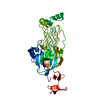 7mzwC  7mzxC 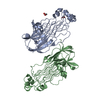 7mzyC  7mzzC C: citing same article ( M: map data used to model this data |
|---|---|
| Similar structure data | |
| EM raw data |  EMPIAR-10930 (Title: Anaplastic lymphoma kinase (ALK) extracellular fragment of ligand binding region 648-1025 in complex with AUG-alpha EMPIAR-10930 (Title: Anaplastic lymphoma kinase (ALK) extracellular fragment of ligand binding region 648-1025 in complex with AUG-alphaData size: 10.2 TB Data #1: Unaligned multi-frame micrographs of 2:2 ALK:AugAlpha complex [micrographs - multiframe] Data #2: Aligned single-frame micrographs of 2:2 ALK:AugAlpha complex [micrographs - single frame]) |
- Links
Links
- Assembly
Assembly
| Deposited unit | 
|
|---|---|
| 1 |
|
- Components
Components
| #1: Protein | Mass: 39377.559 Da / Num. of mol.: 2 / Mutation: C66Y Source method: isolated from a genetically manipulated source Source: (gene. exp.)  Homo sapiens (human) / Gene: ALK / Production host: Homo sapiens (human) / Gene: ALK / Production host:  References: UniProt: Q9UM73, receptor protein-tyrosine kinase #2: Protein | Mass: 14640.013 Da / Num. of mol.: 2 Source method: isolated from a genetically manipulated source Source: (gene. exp.)  Homo sapiens (human) / Gene: ALKAL2, FAM150B, UNQ542/PRO1097 / Production host: Homo sapiens (human) / Gene: ALKAL2, FAM150B, UNQ542/PRO1097 / Production host:  Has protein modification | Y | |
|---|
-Experimental details
-Experiment
| Experiment | Method: ELECTRON MICROSCOPY |
|---|---|
| EM experiment | Aggregation state: PARTICLE / 3D reconstruction method: single particle reconstruction |
- Sample preparation
Sample preparation
| Component | Name: hetero-tetrameric complex of anaplastic lymphoma kinase (ALK) with Augmentor alpha Type: COMPLEX / Entity ID: all / Source: RECOMBINANT | ||||||||||||||||
|---|---|---|---|---|---|---|---|---|---|---|---|---|---|---|---|---|---|
| Molecular weight | Value: 108 kDa/nm / Experimental value: YES | ||||||||||||||||
| Source (natural) | Organism:  Homo sapiens (human) Homo sapiens (human) | ||||||||||||||||
| Source (recombinant) | Organism:  | ||||||||||||||||
| Buffer solution | pH: 7.4 | ||||||||||||||||
| Buffer component |
| ||||||||||||||||
| Specimen | Conc.: 1 mg/ml / Embedding applied: NO / Shadowing applied: NO / Staining applied: NO / Vitrification applied: YES | ||||||||||||||||
| Specimen support | Grid material: GOLD / Grid mesh size: 300 divisions/in. / Grid type: Quantifoil R1.2/1.3 | ||||||||||||||||
| Vitrification | Instrument: FEI VITROBOT MARK IV / Cryogen name: ETHANE / Humidity: 95 % / Chamber temperature: 283.15 K Details: QUANTIFOIL R1.2/1/3 gold 300 mesh grids without glow-discharge, blotting time 3 sec., blotting force -5. |
- Electron microscopy imaging
Electron microscopy imaging
| Experimental equipment |  Model: Titan Krios / Image courtesy: FEI Company |
|---|---|
| Microscopy | Model: FEI TITAN KRIOS / Details: SerialEM coma-free alignment |
| Electron gun | Electron source:  FIELD EMISSION GUN / Accelerating voltage: 300 kV / Illumination mode: FLOOD BEAM FIELD EMISSION GUN / Accelerating voltage: 300 kV / Illumination mode: FLOOD BEAM |
| Electron lens | Mode: BRIGHT FIELD / Nominal magnification: 105000 X / Nominal defocus max: 1500 nm / Nominal defocus min: 500 nm / Cs: 2.7 mm / C2 aperture diameter: 70 µm / Alignment procedure: COMA FREE |
| Specimen holder | Cryogen: NITROGEN / Specimen holder model: FEI TITAN KRIOS AUTOGRID HOLDER / Temperature (max): 98 K / Temperature (min): 96 K |
| Image recording | Average exposure time: 4.2 sec. / Electron dose: 81 e/Å2 / Film or detector model: GATAN K3 (6k x 4k) / Num. of grids imaged: 1 / Num. of real images: 2498 / Details: 4.2 second exposure, 70 frames, total dose 81e |
| EM imaging optics | Energyfilter name: GIF Bioquantum / Details: Gatan energy filter / Energyfilter slit width: 20 eV |
- Processing
Processing
| Software | Name: PHENIX / Version: 1.19_4092: / Classification: refinement | ||||||||||||||||||||||||||||||||
|---|---|---|---|---|---|---|---|---|---|---|---|---|---|---|---|---|---|---|---|---|---|---|---|---|---|---|---|---|---|---|---|---|---|
| EM software |
| ||||||||||||||||||||||||||||||||
| CTF correction | Details: ctfFIND4 within Relion3.0 software / Type: PHASE FLIPPING AND AMPLITUDE CORRECTION | ||||||||||||||||||||||||||||||||
| Particle selection | Num. of particles selected: 2266541 / Details: particles selection was done in cisTEM software | ||||||||||||||||||||||||||||||||
| Symmetry | Point symmetry: C2 (2 fold cyclic) | ||||||||||||||||||||||||||||||||
| 3D reconstruction | Resolution: 2.27 Å / Resolution method: FSC 0.143 CUT-OFF / Num. of particles: 188516 / Algorithm: FOURIER SPACE / Details: cryoSPARC / Num. of class averages: 1 / Symmetry type: POINT | ||||||||||||||||||||||||||||||||
| Atomic model building | Protocol: RIGID BODY FIT / Space: REAL | ||||||||||||||||||||||||||||||||
| Refine LS restraints |
|
 Movie
Movie Controller
Controller



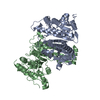

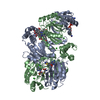
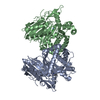
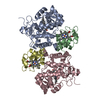



 PDBj
PDBj

